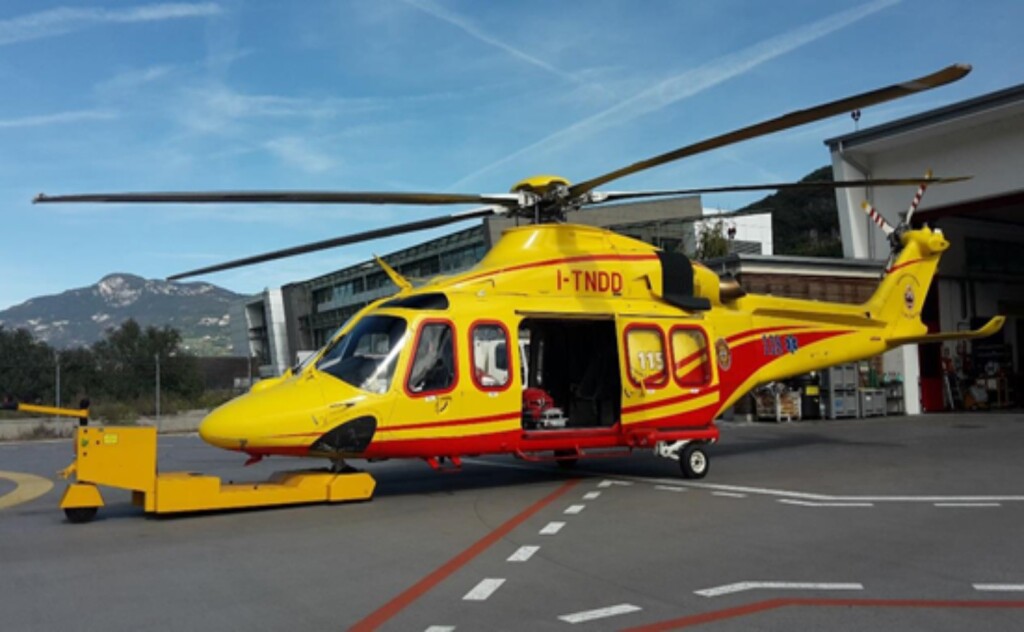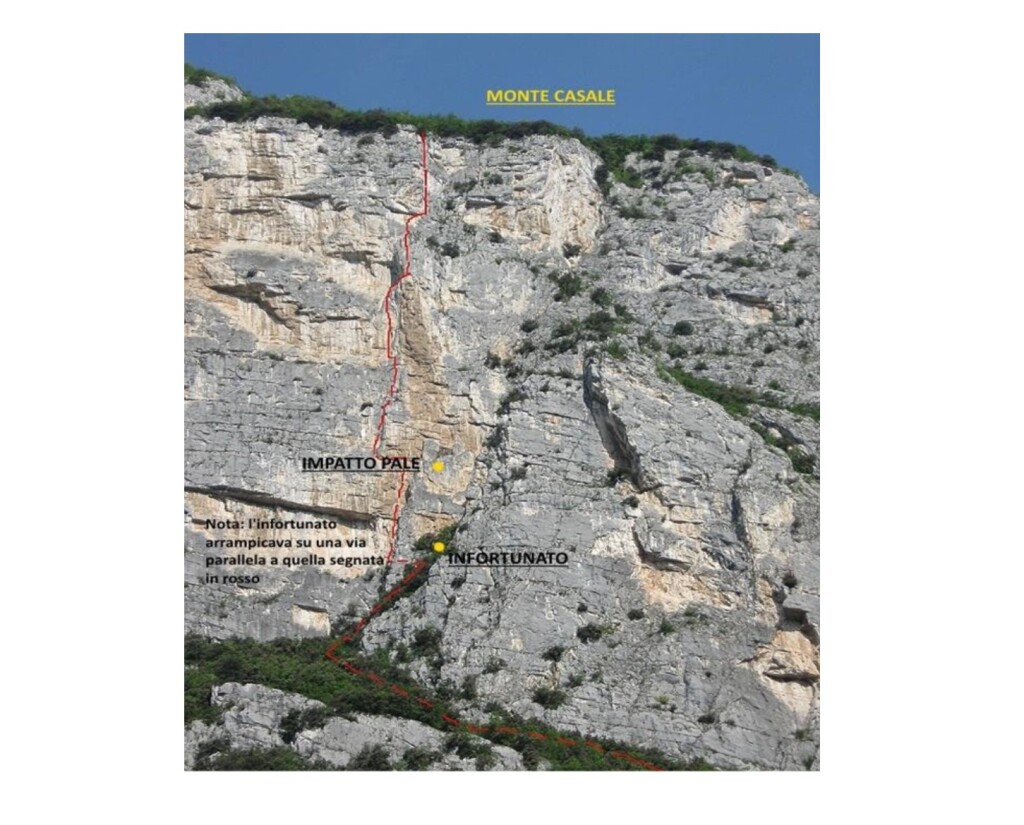Italian Alps AW139 Mountain Rescue Hoisting Blade Strike (Vigili del Fuoco I-TNDD)
On 7 October 2017 Leonardo AW139 I-TNDD of the Vigili del Fuoco fire and rescue service was conducting a hoist rescue mission at Monte Casale, near Trentino in Northern Italy, when it suffered a main rotor blade strike on a cliff face. The aircraft landed safely and an attempt was made to assess the damage while rotors running. The aircraft then made a further flight to Trento Mattarello Airport.

Vigili del Fuoco Leonardo AW139 I-TNDD after Main Rotor Blade Strike During SAR Hoisting (Credit: ANSV)
The Accident Flight
The Italian National Agency for Flight Safety (ANSV) explain in their safety investigation report (issued only 0n Italian on 8 September 2021) that the aircraft had been tasked at 08:14 after the fall of a young climber. The boy was near the base of a cliff at 2100 ft AMSL. The weather was good and the wind was negligible.
On board the hoist-equipped helicopter were three crew (pilot, hoist operator and winchman) and two medical personnel. The single pilot had 5992 hours of experience, 715 on type and 3200 hours of HEMS / rescue flying. If a HEMS mission the hoist operator would have been sat next to the pilot as the HEMS Technical Crew Member (TCM) on the outbound flight.
The unit at Trentino had two AW139s and an Airbus AS365N3. In 2016 it had carried out 2488 taskings and flew 1059 hours.
The casualty was rapidly located and initially the winchman was lowered to assess the casualty. Then while hoisting down the two medical personnel from c 25-20 m AGL at 08:27 there was “a slight variation in the noise of the rotor itself is heard and consequently a slight oscillation of rotor revolutions and torque occurs”.
The ANSV comment that only the pilot appeared to notice this. A few seconds later the pilot told the hoist operator that a blade strike had occurred and they had seen “a cloud of dust on the [cliff] wall, in the upper left”. The aircraft diverted to Pietramurata, about two minutes away. During that flight no abnormal vibration was felt. After landing, the rotor remained running as the hoist operator exited the aircraft to examine the rotor tips. Damage was evident but after discussion the decision was made to return to home base at Trento Mattarello Airport, influence by the lack of vibration.
During that 6 minute 20 second flight, there was further discussion on the incident. The pilot believed they must have struck a well camouflaged outcrop having been convinced they had c 1.5 m of clearance.
On shut down it was found that the helicopter suffered loss of 70 – 80 mm of each of the five main rotor blades and damage to the leading edge protection strips.
Safety Investigation / Analysis
The ANSV comment on the pilot workload when operating single pilot and note that…
….listening to the CVR shows the complexity of the rescue intervention…
They comment that:
It is reasonable to believe that the greyish-yellow background of the rock face…the helicopter was positioned orthogonally [from] did not help the pilot in determining the distance of the main rotor blades from the wall itself, taking into account that the blades, in the last part, are painted yellow to define the outer limit, however, blending in with the background of the aforementioned wall.
The ANSV note that the helicopter was not equipped (nor was it required to be equipped) with any obstacle detection system. Such systems are available for the AW139. They note that after the loss of a Babcock HEMS AW139 EC-KJT in 2017 they had recommended that “operators adequately take into consideration aircraft equipment in their process of analysing and managing the risks associated with the HEMS environment and that ENAC [the regulator] make it the subject of assessment during the surveillance of operators
The investigators also observe that a second qualified person in the cockpit would have been useful.
In relation to the return to base:
The problem of “attention” has been and is being studied in the context of human factors. In summary, in cognitive processes, attention allows you to select some stimuli while ignoring others. When, as in the case in question, we focus excessively on a stimulus…, we tend to lose sight of the general context, with the consequence of neglecting other essential information in moments of particular criticality.
In the case of the I-TNDD pilot their attention was focused on a single aspect (the controllability of the aircraft), which they evidently considered so important that he excluded all other information. As highlighted in the aeronautical field by human factor scholars, the negative aspect of this polarization of attention is that of slipping into a kind of “black hole”, where awareness of the situation is lost, cutting out other information / evaluations.
The channelling of attention can cause dangerous fixations and complacency phenomena, here understood as the inability to get out of a course of erroneous actions due to the restriction of references to those who generate the wrong action.
Safety Resources
The European Safety Promotion Network Rotorcraft (ESPN-R) has a helicopter safety discussion group on LinkedIn. You may also find these Aerossurance articles of interest:
- Italian HEMS AW139 Inadvertent IMC Accident
- SAR Crew With High Workload Land Wheels Up on Beach
- Sécurité Civile EC145 Mountain Rescue Main Rotor Blade Strike Leads to Tail Strike
- Sécurité Civile EC145 Mountain Rescue Blade Strike
- Sécurité Civile EC145 SAR Wirestrike
- Ditching after Blade Strike During HESLO from a Ship
- HEMS Babcock MCS Portugal AW109S Collided With Radio Mast During Night Flight
- SAR Helicopter Loss of Control at Night: ATSB Report
- Japanese Rescue B412 Fatal CFIT
- Swedish SAR AW139 Damaged in Aborted Take-off Training Exercise
- Plan Continuation Bias & IIMC in Kenyan Police AW119 Accident
- SAR AW139 Dropped Object: Attachment of New Hook Weight
- Norwegian HEMS Landing Wirestrike
- AW139 Brownout Accident with the Nigerian VP Aboard
- Fukushima Police Leonardo AW139 Accident: JTSB Update
- Military SAR H225M Caracal Double Hoist Fatality Accident
- Tail Rotor Lightning Strip Damages AW139 Main Rotor
- RLC B407 Reverses into Sister Ship at GOM Heliport
- A HEMS Helicopter Had a Lucky Escape During a NVIS Approach to its Home Base
- Dim, Negative Transfer Double Flameout
- Low Recce of HEMS Landing Site Skipped – Rotor Blade Strikes Cable Cutter at Small, Sloped Site
- US Fatal Night HEMS Accident: Self-Induced Pressure & Inadequate Oversight
- The Tender Trap: SAR and Medevac Contract Design Aerossurance’s Andy Evans discusses how to set up clear and robust contracts for effective contracted HEMS operations.
- UPDATE 20 November 2021: NVIS Autorotation Training Hard Landing: Changed Albedo
- UPDATE 15 January 2022: Air Ambulance Helicopter Struck Ground During Go-Around after NVIS Inadvertent IMC Entry
- UPDATE 22 January 2022: Pedestrian Seriously Injured by Air Ambulance Landing at Melbourne Hospital
- UPDATE 28 December 2022: Night Mountain Rescue Hoist Training Fatal CFIT




Recent Comments